|
A chess game, like many
things, can be divided into three distinct sections: the opening, the
middle and the end.
The Opening
1.e4 e5 2.Nf3 Nc6 3.Bc4 Bc5 4.b4 Bxb4 5.c3
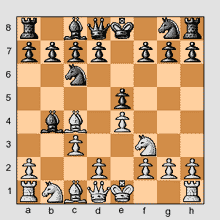 ... ...
Samuel Rosenthal was born in Poland just
a few months after Paul Morphy was born in New Orleans. Like Morphy, he
would become a blindfold specialist but he would also revel in sighted
simultaneous events. He gained a certain amount of renown as the house
player at the Café de la Régence. He was also author David Shenk's
great-great-great grandfather.
In this game, Rosenthal was playing
black against the great tactician from Breslau, Adolf Anderssen.
Although he was 55 when this game was played in Vienna in 1873,
Anderssen was still a powerful force in chess.
Richard Eales' Chess: The History of a
Game has been to me a benchmark for a particular genre of chess
history that deals with the societal aspects of the game. While Eale's
book attempted to understand the growth of the popularity of chess through
the ages, Mr. Shenk explored the impact of chess on the societies in which
it flourished. There's little doubt in my mind that either book achieved
it's purpose.
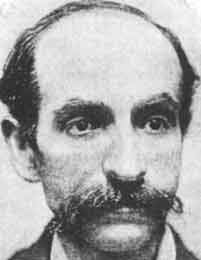
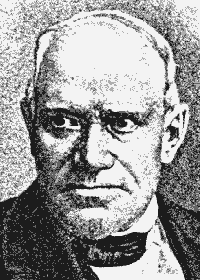
Samuel Rosenthal
Adolf Anderssen
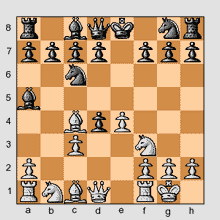
5. ... Ba5 6.d4 exd4 7.O-O
This opening is known as the Evans
Gambit. White sacrifices a pawn for development and central control.
While this opening was highly popular during the 19th
century, with advancing theory it lost much of its bite until Garry
Kasparov revived it in 1995 with his famous win against Anand. Anderssen
was considered a specialist in the Evans Gambit. Over a dozen years
earlier, his handling of the
black pieces against Morphy, who called the Evans "that most beautiful
of openings," caused Morphy to believe that the game was "indubitably
lost for the first player if Black plays correctly."
Just as openings follow a known course, The Immortal Game treads on
familiar territory with its story of the history of chess. But such a history
is so rich and varied that each retelling leaves its own footprints. Mr.
Shenk contrived to tell the story of this immortal game within the
framework of Anderssen's so-called Immortal Game played against Lionel
Kieseritzky in 1851.
The story flows in a most engaging fashion, presented in such a way that
players and non-players alike could find intriguing. But the known course,
however well presented, is just so much familiar ground. The real fun
begins with...
The Middle Game
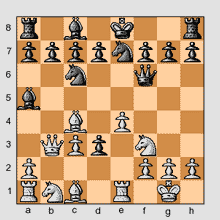
7. ...d3 8.Qb3 Qf6 9.Re1 Nge7
Anderssen had poised his pieces to attack.
Rosenthal prepared to castle and complete his development. But his
forces, while well defended, were disjointed.
Mr. Shenk's opening sentence reveals the essence of his book:
Stories do not exist to tell facts,
but to convey the truth.
The Immortal Game is all about
truth. Truths and ideas on how these truths connect together, relate to
us, affect the culture where they developed and impact mankind in general.
Chess, throughout history, has had many roles- as a game, as a symbolic
representation, as a political tool, as an intellectual benchmark. The
perfunctory, even if astutely written, history presented by Mr. Shenk was
a necessary feature particularly since the book is targeted towards the
general population. But the history contains only the facts and telling
facts was not the book's raison d'etre. The power of this
book, and the thing that kept me turning it's pages, was the perceptive,
and sometimes surprising, glimpses into some of the truths that the history
conceals.
Mr. Shenk tenders
insight into some of the sociological implications of chess, such as:
Chess, as a true game of skill,
reinforced that "ideas were more important and more powerful than luck
or brute force"
and demonstrated that man had control over his life and
wasn't totally subject to the whims of fate -
"...the chess
allegory imagines its subjects to possess independent bodies
in the form of pieces bound to the state by rules rather than by
biology.
as well as some common sense,
yet rarely expressed understandings, such as explaining the wealth of
tactics, even at the expense of strategic soundness, that was the hallmark
of the Romantic Era:
"In a game that presented
trillions upon trillions of possibilities, effective strategic planning
was simply too difficult to intuit; instead it took hundreds of years to
evolve."
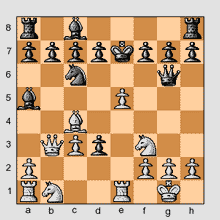
10.Bg5
Qg6 11.Bxe7 Kxe7 12.e5
Black is paying dearly for its single pawn advantage.
(11. ...Nxe7 seems a much better move....
12. Ne5 Qf6 13. Nxf7 Bb6 14. Rf1 Rf8)
In Chess, as in Life, mistakes are often punished severely.
We follow Mr.
Shenk as he sketches chess on its long migratory sojourn from Persia to
Spain accompanying the caches of ancient knowledge, often as a means of
conveying, or at the least reflecting, that knowledge. We follow him
as he traces chess through time with such diverse guides as Fra Jacobus de
Cessolis, John Locke, Alfred Binet, Ben Franklin, Marcel Duchamp and
Vladimir Nabokov until we reach the present and anticipate the future of
this seemingly endless, nearly infinite, immortal game.
The End Game
This game really has no
striking endgame phase as it ends abruptly with a tactical coup.
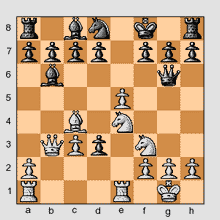
12. ...Kf8
13.Nbd2 Bb6 14.Ne4 Nd8
13. Nbd2, such a quiet move...... will lead to mate.
Within the framework of Anderssen's Immortal Game, Mr. Shenk employed a
sub-text of his own venture into the world of Chess, trying to understand
its connection to the cultures it touched as well as his own personal
connection to his ancestor, Samuel Rosenthal. As his understanding grew,
mirroring the historic developmental stages of the game, he became
increasing aware of the complexity, the depth and the potentially
addictive appeal that chess possesses - something one can only really
taste through immersion. He visited the Chess-in-Schools program in New
York City where he found light in the black hole of chess' depths; he
traveled to Ströbeck, the medieval chess village of Germany on his way
from Berlin, where he participated in a symposium of chess historians, to London to take in the
atmosphere of Simpson's on the Strand where Anderssen and Kieseritzky
created their Immortality.
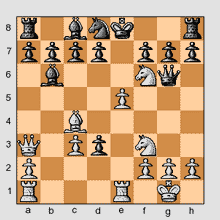
15.Qa3+
Ke8 16.Nf6+
16. ...gxf6 17. exf6+ Qe4
18. Rxe4+ Ne6 19. Qe7#
1-0
The unassuming Knight, traveling its
three squares unimpeded
and with surprising
subtlety, forced black into resignation.
The games ends.
But the end is just a new beginning. Chess started nearly a millennium and
a half ago as a different breed of game
-one of skill, not of chance- a game for the intellect. Today, it's still
a game for the intellect, even a scale on which
to measure the intellect. New technology, technology that chess helped to
develop, has in turn changed the way chess is played as well as the
direction chess is likely to follow.
Many people have predicted the end, the solving, of chess -
forgetting that immortals never end. The
Post-Mortem
Chess, out of respect and necessity, is
generally played in austere silence. Ideas, calculations and observations
ferment inside the players and those watching the game frothing and
building up emotionally-charged pressure, waiting for a moment of release
- a moment that only occurs when the game has ended. This is the
post-mortem phase where the game is analyzed and discussed.
The Immortal Game,
comprised of 327 pages, seems too thin for its contents. This can only be
explained by the tightness of Mr. Shenk's writing. The cover features an
immense black rook with the title (a long title reminiscent of those of
early chess books) presented in an eternal circle. A content list in the
front and an index in the back help in navigating the pages. In addition
to the text of the book, Mr. Shenk offers a detailed list of "Sources and
Notes," four pages of acknowledgements, the Rules of Chess, five annotated
historic games, and the text to Ben Franklin's The Morals of Chess.
The book contains too few photographs or illustrations but an adequate
number of chess diagrams.
While any history of chess
can be as involved or as sparse as the author desires, Mr. Shenk seems to
have found an ideal proportion, balancing the general with the specific.
Since the book is more about ideas, the specifics used mostly illustrate
or support those ideas. If one wanted to try to understand how and why
chess developed from its beginnings to the present, I can think of no
better book than this one. It's well researched, carefully edited,
succinctly written and cleverly arranged.
While I'm somewhat interested
in chess history myself and had encountered most of the information within
the book, I was pleasantly surprised to learn a few things - such as how
Marco Polo and Kublai Khan communicated through chess.
While the book is highly
accurate (in my opinion), there are some points where I tend to hold a
differing viewpoint. One was the conclusions in Mr. Shenk's discussion of genius and
another in his evaluation of Alekhine. I thought not enough emphasis was
given to the role of the invention of the printing press in the
development of chess and that Nikolay Krylenko's role was presented as
somewhat benign with no mention of his problemists purge.
The one (very minor) verbal
blunder that I noticed, ironically enough, occurred in the final moves of
the Immortal Game itself. After 22.Qf6+, Mr. Shenk wrote, "Anderssen
offered up his Queen to Kieseritzky's g8 Knight." Since Kieseritzky
had no other move, there was no offer but rather a forced sequence.
Sometimes Chess gives you no choice.
Some Pertinent Links:
The Immortal
Game Homepage
David Shenk's personal page
Outline of The Immortal Game by Bill Wall
The Immortal Game at Amazon.com
New York Times Review
Interview with David Shenk
(4 min. 30 sec.) from Good Morning America (9/4/06
10:45 am EST)
|
|
The miniature incorporated into the above review
was, of course, an anomaly. Many of the greatest players, including Anderssen,
have lost quick games. The database,
chessgames.com, gives six games between
Anderssen and Rosenthal with Rosenthal winning 3, Anderssen winning 2 and 1
draw.
Those games are playable through the viewer on
the left.
|
|

